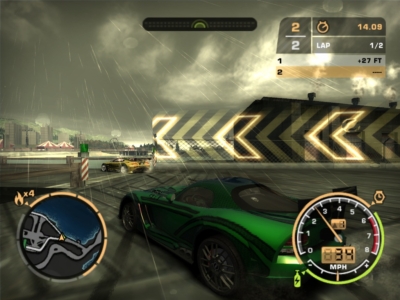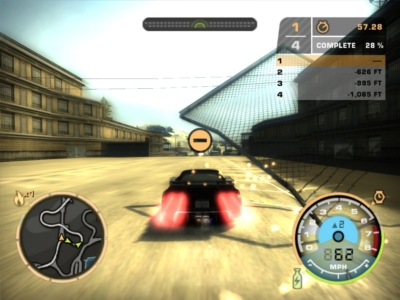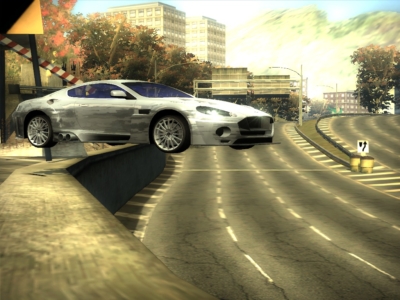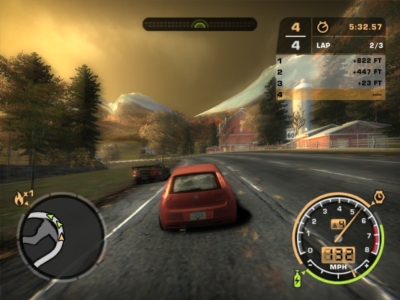
Need for Speed: Most Wanted
Written by: Rik
Date posted: December 31, 2011
- Genre: Racing
- Developed by: Electronic Arts
- Published by: Electronic Arts
- Year released: 2005
- Our score: 9
The loading screens in Need for Speed: Most Wanted feature a set of lights from the top of a police car, which flash intermittently – red, white and blue – while you wait for the game to start. Once you get to the title screen, they’re there again, flashing on and off on an otherwise static image of some police cars pursuing a ludicrously-decorated BMW. Then you get into playing the game, and soon enough the lights are there again – flickering and flashing atop the first couple of cop-cars that happen to notice your ignorance of the highway code. At first, this repetition seems of little significance; the kind of presentational gloss that you’d expect from EA acting as a not-so-subtle reminder that (if you hadn’t already guessed from the game’s title and packaging), after being absent for a couple of years, the police are back.
Fast forward a few days, and you’re in the middle of a police chase during which you’ve been surrounded by extremely aggressive police and federal vehicles, sirens blazing and lights flashing, for the best part of 20 minutes. Finally – finally – you manage to lose them all for long enough to look for a hiding place. All of a sudden, it might all be over, but you can’t relax until it definitely is – please, God, let there be no more chasing, no more roadblocks, no more sirens, no more lights. In real life, it’s getting late. You go to bed and close your eyes, but the lights are still there – flickering in the dark, on and off, red, white and blue. The next day, you get up and drive to work in your underpowered shitheap of a car. On the other carriageway, an ambulance speeds towards an emergency. But you don’t see that it’s an ambulance. It’s got a siren. And flashing lights. And it’s coming for you. [I think you’re losing it – FFG reader]
For me, the fear of getting caught by the cops has always been what Need for Speed – or, indeed, any game involving racing on ‘real-life’ roads – is supposed to be about. EA, on the other hand, haven’t always been able to decide whether the police should be in or out, removing and reinstating them to the series almost on a yearly basis. While the presence of police chases isn’t exactly a guarantee of quality (see 2002’s mostly-ignored Hot Pursuit 2), nor does their absence result in a duff game (hello, Porsche 2000) it is what the series is known for, and by 2005 their return was long overdue.
Most Wanted represents a mish-mash of previous approaches, retaining the street-racing angle of Underground and its sequel (not, at the time of writing, covered on FFG) but adding the outlaw element from earlier entries in the series. (Frankly, it never seemed to make much sense to cast you as a bad-boy racer punk without ever having the possibility of getting into any trouble). The main action is to be found in the career mode, during which you’re asked to tackle a mixture of races and police chases, in pursuit of the somewhat spurious title of ‘most wanted’ street-racer in the imaginary city of Rockport. There’s a rather silly storyline attached to all this, too, the details of which are, as ever, brief and unimportant (although some of the cut-scenes have significant amusement value – see First I’m gonna take your ride, then your girl, for more).
Anyway, you start the game at the bottom of the street-racing pile (known as ‘the blacklist’), as – presumably – the city’s ‘least-wanted’ driver. To move up the list, you need to challenge and defeat the rival above you in a series of head-to-head races, but before you can do that, you need to prove yourself by winning a set number of races and getting in trouble with the law to a sufficient extent to satisfy your opponent.
Much of the racing is fairly straightforward, and most of the available race types will be immediately familiar to anyone who’s played Underground. Circuit, Sprint and Lap Knockout all involve a race against three AI opponents through a designated section of the fictional city of Rockport – Circuit involves laps, Sprint is a point-to-point race, and Lap Knockout is the same as Circuit except the last-placed racer is eliminated at the end of each lap. Drag races are less common, but take the same gear-shift/lane change format as in previous games. New to Most Wanted are the slightly more interesting Speedtrap, where you have to stay near the front of the race but victory is ultimately achieved by passing certain speed cameras at a higher speed than your opponents; and Tollbooth, which is effectively a time-trial, albeit one that involves dodging traffic and, occasionally, the attentions of the police.
Generally, though, the police keep out of your way during races. Raising the price on your head (your ‘bounty’) and achieving other milestones (such as hitting a set number of police cars, avoiding roadblocks, or evading a pursuit within a time-limit) is by-and-large a separate endeavour. Technically, you can just drive around looking for trouble (Most Wanted allows you to drive around the city, á la Grand Theft Auto, although it’s largely a pointless endeavour given that you can just skip straight to all races and events) but you can also ask the game to just drop you straight into a pursuit. With one or two exceptions, it’s rarely necessary to attempt to actually achieve an individual milestone; rather, it’s best to just involve yourself in a chase, and, if it goes on for long enough, you’ll find that a number of milestones have been passed along the way.
Of course, the longer a chase goes on, the harder it is to keep going, and the harder it is to evade capture. In a manner similar to Grand Theft Auto, your wanted level increases as your infractions increase in severity. At lower levels, it’ll be a couple of squad cars chasing you with a limited amount of enthusiasm, but as things heat up, there’ll be roadblocks, federal police and helicopters after you. Thankfully, you can also increase your bounty and rack up milestones by completing ‘Phototicket’ challenges, which involve you having to race past a specific speed camera at a particular speed (and, as such, are usually quite brief).
Despite dragging the action into the daytime from the darkness and neon of its immediate predecessors, Most Wanted’s Underground roots are apparent. The slippery handling, come-to-a-stop collisions, and AI catch-up have all been retained, and, as in Underground, defeat is often snatched from the jaws of victory at the last second, which is particularly irritating at the end of a long lap-based race. The plus is, of course, that it keeps the tension level high, making for some exciting races, but there’s also an element of blundering through without necessarily putting in some good lap times. The newer modes, particularly Tollbooth, are generally more engaging.
The police chases are undoubtedly where the bulk of the fun is to be had. Although evading attention is relatively straightforward, the requirement to stir up significant trouble in order to increase your bounty and hit your targets means that you get embroiled in some very tough pursuits. The city of Rockport has a good mixture of packed urban spaces and high-speed open road, and racing on the latter at high speed with police on your tail is a genuine thrill. Throw in the added tension of avoiding capture (which immediately evaporates any bounty and/or any milestones achieved during the chase, as well as increasing the chances of your car being impounded) and you become increasingly invested in the experience. There’s a palpable sense of desperation at the end of each chase, as you dodge roadblocks, perform U-turns and frantically search for a hiding place. It’s difficult to evaluate the AI of the police, as it’s generally a case of throwing numbers at you and after you until you eventually crumble under the pressure. What can be said, though, is that you genuinely do feel that pressure, with the state seemingly having inexhaustible resources to keep up the relentless pace of each chase. (For more on the technicalities of this side of the game, see Bounty, the taste of paradise).
By contrast, the races against your rivals, when they come, are a bit of a disappointment. Each is preceded by an embarrassing video sequence hyping up his or her fearsome street reputation and aptitude for driving quickly, only for you to blow them away with relative ease in the races themselves. When you win, you can win cash, parts or other goodies – perhaps even your opponent’s car. It’s generally a good idea to have two or three decent cars at your disposal, incidentally, just in case one of them is impounded by the police after one-too-many arrests.
Overall, the career mode in Most Wanted is a fairly hefty challenge, although, like Underground, the sheer number of fairly identical lap-based races does make it rather a test of endurance at times. Here, though, the police chases shake things up somewhat, providing a different kind of challenge, even if their high-stakes nature can make for some explosive temper tantrums if things go wrong. In the unlikely event that you haven’t had your fill once you’ve reached the end of the main story, there are other one-off races and challenges that you can select from the main menu.
On the audio-visual front, there’s little to complain about, and though time is likely to dim the impressive sheen of the graphics, at the time of writing it’s fair to say that Most Wanted is a very nice-looking game indeed. If one were being pernickety then an argument could be made that the Rockport streets and scenery are a little on the generic side, and that the sun-glare and rain-on-the-lens effects are slightly gimmicky, but there’s little else to say other than it’s a slick and well-presented affair. Sound is a mixture of realistic-sounding engine effects and the usual collection of youth-oriented rap/rock, which I don’t personally mind so much, even if my brain was unable to remember any specific details, instead choosing to glue elements of lots of different individual tracks together to create one generic Most Wanted song that was seemingly playing on loop.
In some ways, Need for Speed: Most Wanted feels like just another game in the series. Structurally and technologically, much of the racing is only a small evolutionary step away from its immediate predecessors. Yet, by combining the racing with a law-evading element, the career mode becomes a more varied and digestible challenge than in previous years. Moreover, the return of the police to the series is an appropriate one, reminding long-term fans why they became interested in Need for Speed in the first place.
Personally, Most Wanted does pretty much everything I’d want and expect from any arcade road-racer, and for me, the fact that I kept coming back to the career mode, despite the grinding nature of the races and the occasional frustrations of the police chases, is what sets it apart from its competitors and stable-mates. Like all the best arcade racers, it’ll leave you bathed in sweat with an angry expression on your face and your teeth ground down to a fine powder by the time you’ve reached the end (not to mention the occasional night’s sleep disturbed by thoughts of flashing lights and police chases) but, like all the best arcade racers, rather than giving up, you won’t stop until you’ve beaten it.






 Posts
Posts
Hi Rik,
have you ever tried to play the Most Wanted remake, developed by Criterion Games? I enjoyed very much the EA’s original, and I sometimes come back to it, like you do, but I wouldn’t mind to try the new one, too.
Though there are mostly positive reviews of the remake, the Criterion’s Burnout series-like approach to the new NFS titles don’t excite me too much: I’m talking from experience of playing the new Hot Pursuit and Rivals, where the behaviour of the cars is quite strange, less accomodating and more “on rails” than, say, in original Most Wanted. So I don’t know, whether or not the remake of Most Wanted is worth any spending.
If you had an experience with the remake, please let me know.
Thanks.
November 28, 2016 @ 1:19 pm
Hi Oleg,
I’ve got the Criterion NFS games – both Hot Pursuit and Most Wanted – but haven’t spent much time with either yet.
I think, like you, a number of people have issues with the Criterion/Burnout handling model…somehow it doesn’t quite seem right for NFS.
Burnout was the first game I had on PS2 and I’ve owned several of the titles on various formats, but somehow the series – even the much-loved Burnout Paradise – has never quite clicked for me.
I think I’d need to spend a bit more time with the Criterion NFS games to form a proper opinion though.
November 28, 2016 @ 2:36 pm
I tried the Criterion games. While I was (to my surprise) really fond of Hot Pursit, I absolutely abhor their version of Most Wanted.
January 4, 2017 @ 9:24 pm
Hi Rik,
I have already spent a lot of words on this title in the various comments on this site, and I would like to conclude with a handful of considerations, as a person who has explored this game in all ways.
Once, I wrote that it was possible to finish the game by choosing any car, developing it to the limit.
It is not so.
Over the years, I have done three experiments in this regard.
Since the game allows you to mount upgrades “at the back of the shop”, and by winning pink slips, you might as well make it to the final challenge with a car that, objectively, has a higher degree of mechanical and aerodynamic performance than anyone else out there, in Rockport, and that it is not necessarily a Supercar.
Indeed, at the time, after having finished the game with the top exponents in the roaster (Murcielago and Porsche GT), I purposely avoided the Supercars: I wanted to see how much the other proposed models were worth.
On the first try, many years ago, I chose and kept the original Chevrolet Cobalt, but then I had to give up, because, at some point, the car had become unmanageable and too slow – also due to the fact that it has front-wheel drive. At a certain point, it became impossible to finish a “Drag” course, which was crucial for moving on to the next opponent.
Second attempt, with the Toyota Supra (pink slip trophy). Same thing: I developed it to the unthinkable limit, but it had become “capricious”, because it was too heavy to tackle the curves, with the Porsche and Chevrolet Corvette on my back.
Third attempt: Audi 4 (sedan). Despite a high stability on any track, he did not make it against his opponents in the group of the third Most Wanted character.
All this considering that, when you press Pause, you can adjust any aspect of the car on the fly (ground clearance, aerodynamics, etc.). I made extensive use of all of this in my experiments, playing on turbo/aerodynamics in corners, NO2 in starts, and so on.
I have always played with the automatic gearbox, so I don’t know if using the manual gearbox can change the cards on the table.
I understand that such an approach is not intended from the start – after all, anyone is motivated to collect the ever more powerful cars, all the way to the top ones. But also the game itself, while making spare parts available at the back of the shop, which enormously increase the capabilities of any car and thus suggest that you could make it with any of those, in reality, it pushes you to win/buy the more advanced models.
And I’m playing Most Wanted now and having a blast! This time, however, I do things in a more appropriate way.
Happy rest of Sunday!
July 24, 2022 @ 1:43 pm
There are typos in the text, so I need to correct this line here: Third attempt: Audi 4 (sedan). Despite a high stability on any track, it did not make it against it’ opponents in the group of the third Most Wanted character”.
Sorry, I made the translation to English with the “help” of the machine.
July 24, 2022 @ 1:47 pm
Hi Oleg,
Thanks for the info. I always tend to just upgrade when it seems like the option is available/encouraged by the game. I think with this one I had a Golf for a while, then the RX-8 lasted quite a long time… by the end I was rotating the Corvette and Aston Martin (in case of arrest/impound strikes).
Having said that, there is definitely something funky going on with the way car performance works in the Black Box era of this series. You mentioned under the UG review the benefit of/need for arbitrary changes of vehicle towards the end and, thinking about it, I had issues at various points with Carbon, ProStreet and Undercover where I made the ‘wrong’ choice and was made to pay for it.
Anyway, hope you’re enjoying this run through the game – as I mentioned, I recently started a new career and ran through a few races in order to compare with the 2012 version and had to tear myself away – have so far managed to avoid getting sucked back in!
July 27, 2022 @ 5:10 pm
I MADE IT!!!
I managed to prove myself wrong … again! I defeated Razor with a Mitsubishi Lancer, so Supercars aren’t necessary!
Take this, game!
I’d like to dedicate this win to the venerable Tiger Car. Justice is done!
Oh, by the way, I didn’t use mods. The game is patched to version 1.3.
Cheers.
August 4, 2022 @ 11:07 pm
Tiger Car thanks you from the great scrapyard in the sky!
Now you finally have your BMW back, you can start Carbon and immediately lose it again…:)
August 8, 2022 @ 2:02 pm
Yeah, and what a prize that BMW is!
No wonder people began to tweek the in-game model: your car and my Kia Rio 2016 combined, could do better than that one.
\m/
August 13, 2022 @ 10:14 pm